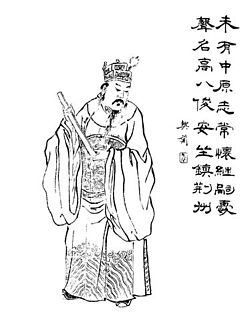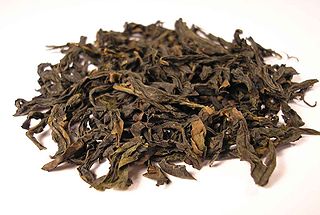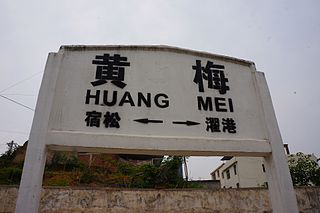
Green tea is a type of tea that is made from Camellia sinensis leaves and buds that have not undergone the same withering and oxidation process used to make oolong teas and black teas. Green tea originated in China, but its production and manufacture has spread to many other countries in Asia.

Chinese tea culture refers to how tea is prepared as well as the occasions when people consume tea in China. Tea culture in China differs from that in European countries like Britain and other Asian countries like Japan, Korea, Vietnam in preparation, taste, and occasion when it is consumed. Tea is still consumed regularly, both on casual and formal occasions. In addition to being a popular beverage, it is used in traditional Chinese medicine as well as in Chinese cuisine.

Engelhardia is a genus of seven species of trees in the family Juglandaceae, native to southeast Asia from northern India east to Taiwan, Indonesia and the Philippines. The genus name is commonly misspelled "Engelhardtia", a "correction" made by the original author Carl Ludwig Blume in 1829 and persistent until today, as it was thus entered in the Index Kewensis; the original spelling is Engelhardia.

Liu Biao (142–208), courtesy name Jingsheng, was a government official and warlord who lived in the late Eastern Han dynasty of China. He is best known for serving as the Governor of Jing Province from 192 until his death in 208. He was also a member of the extended family of the Han emperors through his ancestor Liu Yu, the fifth son of Emperor Jing.Liu Biao was described as a handsome man and was over eight chi tall.
Hepatotoxicity implies chemical-driven liver damage. Drug-induced liver injury is a cause of acute and chronic liver disease.

Astragalus is a large genus of over 3,000 species of herbs and small shrubs, belonging to the legume family Fabaceae and the subfamily Faboideae. It is the largest genus of plants in terms of described species. The genus is native to temperate regions of the Northern Hemisphere. Common names include milkvetch, locoweed and goat's-thorn. Some pale-flowered vetches are similar in appearance, but they are more vine-like than Astragalus.
The Liver is one of the zàng organs stipulated by Traditional Chinese Medicine (TCM). It is a functionally defined entity and not equivalent to the anatomical organ of the same name.

Chinese tea is a beverage made from the leaves of tea plants and boiled water. Tea leaves are processed using traditional Chinese methods. Chinese tea is consumed throughout the day, including during meals, as a substitute for plain water, for health, or for simple pleasure.

Zhang Zai (1020–1077) was a Chinese Neo-Confucian moral philosopher and cosmologist. He is most known for laying out four ontological goals for intellectuals: To build up the manifestations of Heaven and Earth's spirit, to build up good life for the populace, to develop past sages' endangered scholarship, and to open up eternal peace.

In the Chinese martial arts, imagery of the Five Animals —Tiger, Crane, Leopard, Snake, and Dragon—appears predominantly in Southern styles, especially those associated with Guangdong and Fujian Provinces. An alternate selection which is also widely used is the crane, the tiger, the monkey, the snake, and the mantis.

Qilan is a very mild Wuyi oolong tea. It has an obvious sweet and nutty aroma.

Huangmei County falls under the administration of Huanggang City in eastern Hubei province, People's Republic of China, and borders Anhui to the east and Jiangxi to the south across the Yangtze. It also administers Shanjia Islet (单家洲) in the Yangzte.
Huang Chao was a Chinese smuggler, soldier, and rebel, and is most well known for being the leader of a major rebellion that severely weakened the Tang dynasty.
Reverse cholesterol transport is a multi-step process resulting in the net movement of cholesterol from peripheral tissues back to the liver first via entering the lymphatic system, then the bloodstream.

Huangjin Gui is a premium variety of Chinese oolong tea traditionally from Anxi in Fujian province. Named after the yellow golden color of its budding leaves and its unique flowery aroma, it is said to be reminiscent of Osmanthus.
The seven necessities stem from the phrase "Firewood, rice, oil, salt, sauce, vinegar and tea are the seven necessities to begin a day". The items were known as early as the Song dynasty travel book, Dreams of the Former Capital.

Black tea, called hóngchá (红茶) or red tea in China, is a type of tea that is more oxidized than oolong, green, and white teas. Black tea is generally stronger in flavour than the less oxidized teas. All four types are made from leaves of the shrub Camellia sinensis. Two principal varieties of the species are used – the small-leaved Chinese variety plant, used for most other types of teas, and the large-leaved Assamese plant, which was traditionally mainly used for black tea, although in recent years some green and white teas have been produced.













